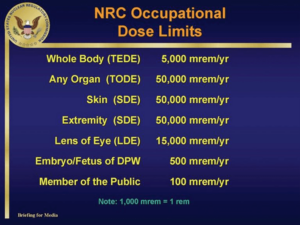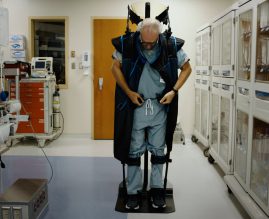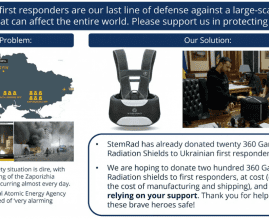Federal Standards and the ALARA Principle
01.08.24 | Monday | Jordan Houri, BSc, MSc
The permitted radiation exposure levels for first responders are set in U.S. federal standards. The levels of permitted exposure rise according to the severity of the situation: from 5 rem for occupational exposure to unlimited exposure in the case of protection of large populations (as long as first responders are aware of the risk, see federal report).
What is the ALARA principle?
A huge caveat accompanies these permitted radiation exposure levels: the ALARA principle. Set forth by both federal and international agencies – this principle requires levels of exposure to be As Low As Reasonably Achievable. For example, although occupational exposures are set at 5 rem, that in no way justifies such exposure if a lower level can reasonably be achieved.
How to Prevent Radiation Exposure – Reasonably
Radiation protection is described in federal reports as a three-pronged endeavor, relying on time, distance and shielding.

Yet in the case of first responders in a major radiologic emergency, it’s important to understand that radiation protection essentially relies on one main aspect– shielding. According to federal guidelines, emergency responders are not limited by time or distance if they need to act to protect large populations and they are informed of the risks of such exposure. In other words, if first responders willingly go in to save lives risking their own, the only thing that can save them from radiation poisoning is shielding.
According to the EPA and other federal agencies: “Incident commanders should make every effort to employ the ‘as low as reasonably achievable’ (ALARA) principle after a [radiological] incident. Still, in some incidents doses above the annual occupational 5 rem (50 mSv) dose limit may be unavoidable….Each emergency worker should make an informed decision as to how much radiation risk they are willing to accept to complete a particular mission.” (Environmental Agency, PAG Manual – Protective Action Guide and Planning Guidance for Radiological Incidents, 2017).
We’ve seen this before, in radiologic emergencies such as Chernobyl and, more recently, Fukushima. Emergency responders went into the affected area knowingly and paid the price. Though they initially tried to restrict time and distance, the pressing tasks at hand required them to stay longer than prescribed in the vicinity of the radiation source. The only thing that could protect them was radiation shielding – of which they had very little. Chernobyl first responders donned makeshift lead aprons to protect themselves, but these efforts were ineffective due to the inability of thin shielding to adequately attenuate energetic gamma radiation, which was present in lethal doses.
Currently Implemented Radiation Shielding
As a DHS report lays out, “”In general, emergency personnel should always practice the As Low As Reasonably Achievable (ALARA) principle to mitigate the hazards associated with radiation. Maximizing distance, minimizing time and using appropriate radiation shielding will reduce the intake of airborne radioactivity and minimize external radiation dose. ” Since time and distance cannot always be restricted sufficiently in radiologic emergencies, the main thrust of radiation protection lies in shielding. Yet, here, too, there is no protection against the most penetrating form of radiation, gamma radiation. Federal recommendations often cite the following measures:
- Specialized respirators to prevent inhalation of alpha and beta radioactive particles.
- Gloves and protective eyewear against alpha and beta radiation.
- Iodine prophylactic medication to protect the thyroid from inhaled or ingested radioactive alpha and beta particles and thus prevent thyroid cancer.
- Dosimeters to measure radiation doses and thus enable informed action and facilitate later medical treatment.
Hazmat suits often go unmentioned as they don’t provide protection against gamma radiation, which is the unanswered threat to first responders. The regular fire protection uniforms provide some protection from alpha and beta radiation while enabling greater mobility than hazmat suits. Federal and international recommendations leave the issue of protective clothing to the consideration of incident commanders and a DHS report even recommends not wearing hazmat suits during RDD response. OECD guidelines state that due to circumstances such as long duration, high temperatures, no available infrastructure and serious hazards relating to electricity, fire or water, some PPE/PCs may not be appropriate for use in a radiologic emergency.
Recent Developments in Radiation Protection
Yet there is a solution to this dire predicament. Recently, the first-ever protective wearable gear to safeguard an individual from exposure to gamma radiation, AKA the 360 Gamma, was developed by StemRad. It is a protective belt with harness that offers targeted shielding to the most vulnerable area of the body – its stem cell factory – thus dramatically increasing chances of survival. This selective shielding technology is critical to the protection of first responders – and to the success of their missions during a radiologic emergency. Is this solution “reasonably achievable?” For an analysis of the 360 Gamma in light of the ALARA principle, tune into our next blog post.
Read up on the technology and testing underlying the 360 Gamma.
Find out about the partnership between StemRad and Lockheed Martin to provide radiation protection to astronauts on the mission to Mars.
Balancing Risk and Responsibility: How Wearable Gamma Shielding Can Uplift First Responder Protection Under ALARA
Protecting First Responders: Balancing ALARA with Gamma Shielding Needs
A revolution in radiation protection has arrived with StemRad’s 360 Gamma, a wearable vest shielding the vital bone marrow from penetrating gamma rays – a first in history. Yet, the crucial question remains: how does this innovation comply with the federal ALARA principle (“As Low As Reasonably Achievable”) for minimizing radiation exposure?
ALARA demands cost-benefit analysis, balancing ongoing risk assessment with available resources. While affordable, equipping every firefighter nationwide might be excessive. However, providing the 360 Gamma in high-risk terror attack zones (identified by DHS) is entirely reasonable. Lower-risk areas could share shields strategically to adhere to ALARA.
Nuclear power plants should also equip workers for emergencies and high-exposure tasks. But who shoulders the responsibility for integrating this tech?
Both local and federal agencies play a role. Local commanders often look to the federal government for guidance, but their discretion in procurement remains high. Still, the federal government can assist through:
- FEMA: providing response policies and maintaining an equipment list for local agencies.
- DHS: offering grants and R&D support.
- EPA: developing radiation safety standards.
- HHS: supporting medical first responders.
- DOJ: supporting law enforcement.
With wearable gamma protection now a reality, applying this selective shielding technology aligns with the ALARA principle and becomes not just good practice, but a moral imperative. Our first responders deserve the best possible protection when facing radiological emergencies. Implementing the 360 Gamma in a nuanced, risk-based manner is a critical step towards safeguarding their lives and fulfilling our duty to prioritize their safety.
Summary
Federal standards set radiation exposure limits for first responders, rising with risk: 5 rem for routine work, unlimited in emergencies (with informed consent). But the ALARA principle demands reducing radiation exposure as much as possible.
For firefighters and rescuers, time and distance limitations often become irrelevant in crises. Their only reliable shield against dangerous gamma rays is proper gear. Hazmat suits lack gamma protection, and standard uniforms offer limited defense.
StemRad’s 360 Gamma introduces a breakthrough: a vest targeting the bone marrow, the “stem cell factory,” to boost survival chances. This selective shielding aligns with the ALARA principle and could be crucial for protecting first responders and ensuring mission success.

Lead Scientist, Space Exploration


